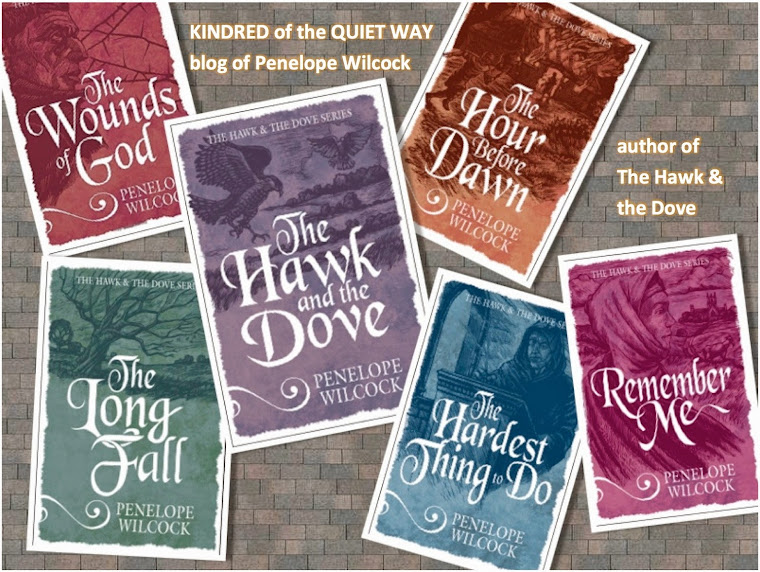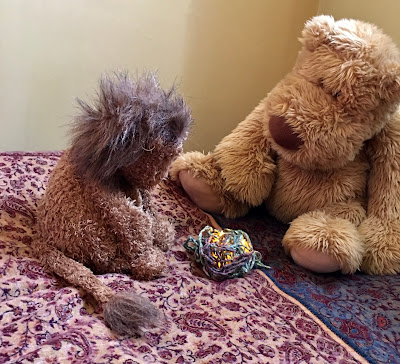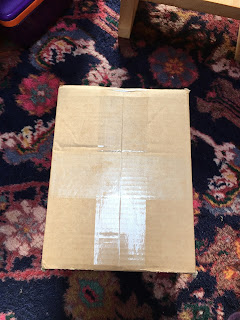On Sunday at The Campfire Kids Church on Facebook, at the event called "Ebenezer" we'll be thinking about making altars.
So you will be all ready and able to join in the activity, I wanted to show you how you might make the main bit of the altar.
Some altars are made of stone or wood, but you can actually make an altar out of anything.
To make an altar in your home, you might clear a windowsill and use that, or put a shelf up on the wall. Tony from The Campfire Church makes altars to go on the wall. Here's one he made.
There's that shelf to put spare prayer cards and other things I might want handy to put up on the altar. Hebe, who is one of the people living in our house, made the little figure of Our Lady, and the matchbox prayer is the one I showed you when we were thinking about unicorns last week.
But of course, kids don't always have permission to clear a whole windowsill where they can make an altar, or someone who will put up a shelf for their altar things. So I wanted to show you some ways to make an altar that kids can do.
I'm going to show you two sorts. The first one is made from a milk carton and the second one is made from a box left over from a parcel that was delivered to our house.
So, here we go. Please read the instructions all the way through first, unless you have several empty milk cartons to make mistakes with.
First you need a milk carton, a hole punch (if your house has one) and some kitchen scissors. And you'll need a kitchen knife.
Please ask before using anything that belongs to someone else. I can tell you now, you might be in big trouble if you take someone's special sewing scissors and use them to cut up a milk carton.
Take the label off the milk carton. They usually peel off quite easily.
Okay. You might need some help with the next bit. Milk cartons are fairly easy to cut, but starting the cut is tricky. The best thing to use is a kitchen knife — a vegetable knife A kid shouldn't do that. Ask an adult. They just need to stick the knife (gently) into the milk carton so there's a hole for the scissors.
Like this.
Right, once that's done you need the scissors for the next bit.
Our altar is going to have a floor and a back wall. So you don't cut all the way round or you'll only have a floor. You cut most of the way round and stop (look at the next few pictures and you'll understand).
Then you cut up and round to make the back wall of your altar. Look at the pictures and you'll see what I mean.
Here's what will be the altar.
This is what's left over, to go in the recycling bin.
Next comes the hole punch. I tried to measure carefully so the hole would be exactly in the middle.
As you can see, I got it wrong, but it doesn't matter much. Just do it as near the middle as you can manage.
Next you hang your altar up on the wall, if you are allowed to.
If there's a handy nail somewhere, just hang it on that. If the nail head is too big to go through the hole, tie a piece of string or ribbon through the hole to hang it up — like this.
If you need a new nail putting into the wall, ask an adult to hammer it in for you. A panel pin would be the right kind of thing. Your altar won't be heavy at all. This is a panel pin.
Here it is, hung up.
You can put into it the matchbox prayer you made last week.
Or you can decorate it. Beshlie-Ann at Glittery Rainbow Cat Face-Painting makes these lovely stick-on decorations, and I have used one of hers.
You can put an LED candle in it — but I don't recommend a real candle for this sort of altar, because it would get too hot for the plastic, and if you put it in a glass jar it would be too heavy.
The bottom of a milk carton is not properly flat, so I folded a hanky to make a mat in the bottom for my candle to stand on.
So that's one kind of altar you can make.Now here's the sort you can make out of a box. Here's my box.
Once you have made the altar, you might like to stash away inside it any pictures or prayers that you want to put on it sometimes but not all the time.
We shall be using the bottom of the box as the top of the altar. So I'll show you how to fold the flaps of the box shut, so it will stay shut and everything you put inside it will stay there and not drop out.
Here we go.
Here's your box open.
Fold down one of the long sides.
Fold one of the short sides down on top.
Fold down the other long side on top of that.
Next comes the tricky bit. Look carefully.
You fold the last short side down on top of the long side you just put in place, then you also tuck that last short side under the first long side. The picture will show you what I mean.
So now the flaps all hold each other in place so the box won't come undone and let everything fall out when you turn it upside down.
Now turn it over.
An altar should be beautiful, so to go on the top you can either draw a picture, or cut one out of a magazine, or print one off from the internet (an adult can help you get the size right).For the one I made, I found a picture of a Persian rug on the internet. I printed it off and cut it out to go on top of my altar.
I stuck my picture on with sticky-backed plastic, but you could use a glue stick, or make glue by mixing flour and water, or you could use sellotape. Whatever you have at home. If you don't have anything it's still okay. You can just lie the picture on top of the altar and that will do fine.
Next I wanted to put something on my altar. I wanted to put prayers on the altar, some to say thank you for things I am happy about, and some with the things I'd love God's help with.
So I got two little boxes — match boxes are the right size for this, or any other small box or little bag you can find at home. I used two boxes that had dressmaking pins in, and tipped the pins into a different container.
On top of one box I stuck a label saying "Please" and on top of the other a label saying "Thank you".
I put those on my altar.
If you do that, you might like to cut some paper up into the right size pieces to go in the little boxes, and have your bits of paper on the altar ready to write your prayers on. Here's Ebenezer getting hers ready.
Then I put onto the altar the prayer I made last week, about the unicorns, and a couple of other prayers I like to keep on my altar, and last but not least — a picture of Jesus.
This is what mine looked like when it was all finished.
On Sunday at The Campfire Kids Church, there will be a chance for you to show us a picture of your own altar, if you decide to make one at home.
And you will be hearing a bit about Ebenezer, and why Ebenezer has a special connection with altars.
See you on Sunday at The Campfire Kids Church!





































































